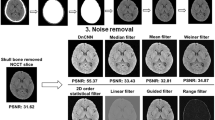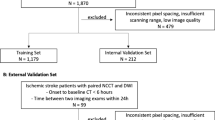Abstract
Alberta Stroke Program Early Computed Tomographic Scoring (ASPECTS) is a reliable method for assessing early ischemic changes in the blood supply area of the middle cerebral artery in patients with acute ischemic stroke. This study aims to propose a deep learning based automatic evaluation strategy for DWI-ASPECTS to serve as a reference for clinicians in urgent decision making for endovascular thrombectomy. Ten ASPECTS regions are extracted from the DWI series to train the independent classification network for each region, the accurate training labels of which are confirmed by neuroradiologists. Two classical convolutional neural networks (VGG-16 and ResNet-50) are validated. Subsequently, the innovative CBAM-VGG is designed to improve the accurate scoring of four small-volume DWI-ASPECTS regions, including caudate nucleus, lenticular nucleus, internal capsule, and insular lobe. Average F1-score of 0.929 and 0.840 and the average accuracy of 94.75% and 84.99% are obtained when scoring on six cortical regions M1-M6 and four small ASPECTS regions, respectively. In addition, the modified algorithm CBAM-VGG shows a significant improvement in the accuracy of estimating the four ASPECTS regions with smaller volumes. The experimental results demonstrate that the deep learning methods facilitate the efficiency and robustness of automatic DWI-ASPECTS scoring, which can provide a reference for clinical decision-making.
Graphical Abstract






Similar content being viewed by others
Data availability
The datasets during and/or analyzed during the current study available from the corresponding author on reasonable request pending the approval of the institution and trial/study investigators who contributed to the dataset.
Abbreviations
- AIS:
-
Acute ischemic stroke
- ASPECTS:
-
Alberta Stroke Program Early Computed Tomographic Scoring
- AUC:
-
Area under the receiver operator characteristic curve
- BN:
-
Batch normalization
- C:
-
Caudate nucleus
- CBAM:
-
Convolutional block attention module
- Conv:
-
Convolutional layers
- CT:
-
Computed tomography
- DWI:
-
Diffusion-weighted imaging
- I:
-
Insular lobe
- IC:
-
Internal capsule
- L:
-
Lenticular nucleus
- MCA:
-
Middle cerebral artery
- ROC:
-
Receiver operating characteristic curve
References
Lindsay MP, Norrving B, Sacco RL et al (2019) World Stroke Organization (WSO): global stroke fact sheet 2019. Int J Stroke 14(8):806–817. https://doi.org/10.1177/1747493019881353
Wang WZ, Jiang B, Sun HX et al (2017) Prevalence, incidence, and mortality of stroke in China results from a nationwide population-based survey of 480 687 adults. Circulation 135(8):759–771. https://doi.org/10.1161/circulationaha.116.025250
Phan K, Dmytriw AA, Lloyd D et al (2019) Direct endovascular thrombectomy and bridging strategies for acute ischemic stroke: a network meta-analysis. J Neurointerv Surg 11(5):443–449. https://doi.org/10.1136/neurintsurg-2018-014260
Barber PA, Demchuk AM, Zhang JJ, Buchan AM, Grp AS (2000) Validity and reliability of a quantitative computed tomography score in predicting outcome of hyperacute stroke before thrombolytic therapy. Lancet 355(9216):1670–1674. https://doi.org/10.1016/S0140-6736(00)02237-6
Ryu CW, Shin HS, Park S, Suh SH, Koh JS, Choi HY (2017) Alberta Stroke Program Early CT Score in the prognostication after endovascular treatment for ischemic stroke: a meta-analysis. Neurointervention 12(1):20–30. https://doi.org/10.1136/neurintsurg-2018-014260
Liu L, Wu B, Zhao JL et al (2017) Computed tomography perfusion Alberta Stroke Program Early Computed Tomography Score is associated with hemorrhagic transformation after acute cardioembolic stroke. Front Neurol 8:591. https://doi.org/10.3389/fneur.2017.00591.eCollection2017
Koenig IR, Ziegler A, Bluhmki E et al (2008) Predicting long-term outcome after acute ischemic stroke - a simple index works in patients from controlled clinical trials. Stroke 39(6):1821–1826. https://doi.org/10.1161/STROKEAHA.107.505867
Pexman JHW, Barber PA, Hill MD et al (2001) Use of the Alberta Stroke Program Early CT Score (ASPECTS) for assessing CT scans in patients with acute stroke. Am J Neuroradiol 22(8):1534–1542. https://doi.org/10.0000/PMID11559501(dummy)
Lee D, Lee J, Ko J, Yoon JY, Hyun RK, Nam Y (2019) Deep learning in MR image processing. Invest Magnetic Resonance Imaging 23(2):81–99. https://doi.org/10.13104/imri.2019.23.2.81
Cai L, Gao JY, Zhao D (2020) A review of the application of deep learning in medical image classification and segmentation. Annals of Translational Medicine 8(11):713. https://doi.org/10.21037/atm.2020.02.44
Li L, Chen Y, Bao Y et al (2020) Comparison of the performance between Frontier ASPECTS software and different levels of radiologists on assessing CT examinations of acute ischaemic stroke patients. Clin Radiol 75(5):358–365. https://doi.org/10.1016/j.crad.2019.12.010
Hampton-Till J, Harrison M, Kühn AL, Anderson O, Grunwald IQJEMJN (2015) Automated quantification of stroke damage on brain computed tomography scans: e-ASPECTS. EMJ Neurol 3(1):69–74
Vilela P, Rowley HA (2017) Brain ischemia: CT and MRI techniques in acute ischemic stroke. Eur J Radiol 96:162–172. https://doi.org/10.1016/j.ejrad.2017.08.014
Goebel J, Stenzel E, Guberina N, Wanke I, Koehrmann M, Kleinschnitz C (2018) Automated ASPECT rating: comparison between the Frontier ASPECT Score software and the Brainomix software. Neuroradiology 60(12):1267–1272. https://doi.org/10.1007/s00234-018-2098-x
Hoelter P, Muehlen I, Goelitz P, Beuscher V, Schwab S, Doerfler A (2020) Automated ASPECT scoring in acute ischemic stroke: comparison of three software tools. Neuroradiology 62(10):1231–1238. https://doi.org/10.1007/s00234-020-02439-3
Kuang H, Najm M, Chakraborty D et al (2019) Automated ASPECTS on Noncontrast CT Scans in Patients with Acute Ischemic Stroke Using Machine Learning. Am J Neuroradiol 40(1):33–38. https://doi.org/10.3174/ajnr.A5889
Yao S, Chien Hung C (2012) Automated ASPECTS scoring system as a clinical support system for acute stroke care. 2012 IEEE-EMBS International Conference on Biomedical and Health Informatics (BHI), 691–694. https://doi.org/10.1109/BHI.2012.6211677
Lee JM, Dziedzic T (2018) Personalizing acute therapies for ischemic stroke Thrombolysis or thrombectomy? Neurology 90(12):535–536. https://doi.org/10.1212/WNL.0000000000005169
Do LN, Baek BH, Kim SK, Yang HJ, Park I, Yoon W (2020) Automatic assessment of aspects using diffusion-weighted imaging in acute ischemic stroke using recurrent residual convolutional neural network. Diagnostics 10(10):803. https://doi.org/10.3390/diagnostics10100803
Willemink MJ, Koszek WA, Hardell C et al (2020) Preparing medical imaging data for machine learning. Radiology 295(1):4–15. https://doi.org/10.1148/radiol.2020192224
Kalavathi P, Prasath VBS (2016) Methods on skull stripping of MRI head scan images-a review. J Digit Imaging 29(3):365–379. https://doi.org/10.1007/s10278-015-9847-8
Mangin JF, Lebenberg J, Lefranc S et al (2016) Spatial normalization of brain images and beyond. Med Image Anal 33:127–133. https://doi.org/10.1016/j.media.2016.06.008
Suhas S, Venugopal CR (2017) MRI image preprocessing and noise removal technique using linear and nonlinear filters. International Conference on Electrical, Electronics, Communication, Computer, and Optimization Techniques (ICEECCOT). Mysuru, India; 709–712. https://doi.org/10.1109/ICEECCOT.2017.8284595
Simonyan K, Zisserman A (2014) Very deep convolutional networks for large-scale image recognition. ArXiv 1409.1556. https://doi.org/10.48550/arXiv.1409.1556
Kaiming H, Xiangyu Z, Shaoqing R, Jian S (2016) Deep residual learning for image recognition. 2016 IEEE Conference on Computer Vision and Pattern Recognition (CVPR), 770–778. https://doi.org/10.1109/CVPR.2016.90
Woo SH, Park J, Lee JY, Kweon IS (2018) CBAM: Convolutional block attention module. 15th European conference on computer vision (ECCV). 11211:3–19. https://doi.org/10.48550/arXiv.1807.06521
Gong J, Liu JY, Hao W, Nie SD, Zheng B, Wang SP (2020) A deep residual learning network for predicting lung adenocarcinoma manifesting as ground-glass nodule on CT images. Eur Radiol 30(4):1847–1855. https://doi.org/10.1007/s00330-019-06533-w
He K, Zhang X, Ren S, Sun J (2015) Delving deep into rectifiers: surpassing human-level performance on ImageNet classification. IEEE International Conference on Computer Vision, IEEE International Conference on Computer Vision, 1026–1034. https://doi.org/10.1109/ICCV.2015.123
Naganuma M, Tachibana A, Fuchigami T et al (2021) Alberta stroke program early CT score calculation using the deep learning-based brain hemisphere comparison algorithm. J Stroke Cerebrovasc Dis 30(7):105791. https://doi.org/10.1016/j.jstrokecerebrovasdis.2021.105791
Funding
This study has received funding by the National Natural Science Foundation of China (Grant No. 81830052), the Science and Technology Innovation Action Plan of Shanghai (Grant No. 18441900500), the Natural Science Foundation of Shanghai (Grant No. 20ZR1438300), and Shanghai Key Laboratory of Molecular Imaging (Grant No. 18DZ2260400).
Author information
Authors and Affiliations
Contributions
All authors contributed to the study conception and design. Material preparation, data collection, and analysis were performed by Yan Wu and Rong Sun. The first draft of the manuscript was written by Yan Wu; all authors commented on the subsequent versions of the manuscript. All authors read and approved the final manuscript.
Corresponding author
Ethics declarations
Ethics approval and consent to participate
An Ethics Committee and Institutional Review Board of the Shanghai Sixth People’s Hospital Affiliated to Shanghai Jiao Tong University have approved the retrospective research; thus, the requirement for subject informed consent was waived.
Consent for publication
Not applicable.
Competing interests
The authors declare no competing interests.
Additional information
Publisher's Note
Springer Nature remains neutral with regard to jurisdictional claims in published maps and institutional affiliations.
Rights and permissions
Springer Nature or its licensor (e.g. a society or other partner) holds exclusive rights to this article under a publishing agreement with the author(s) or other rightsholder(s); author self-archiving of the accepted manuscript version of this article is solely governed by the terms of such publishing agreement and applicable law.
About this article
Cite this article
Wu, Y., Sun, R., Xie, Y. et al. Automatic Alberta Stroke Program Early Computed Tomographic Scoring in patients with acute ischemic stroke using diffusion-weighted imaging. Med Biol Eng Comput 61, 2149–2157 (2023). https://doi.org/10.1007/s11517-023-02867-2
Received:
Accepted:
Published:
Issue Date:
DOI: https://doi.org/10.1007/s11517-023-02867-2




